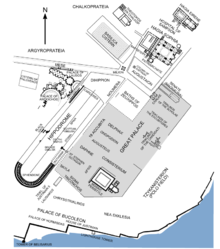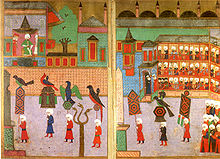Hippodrome of Constantinople
Template:Distinguish2 41°00′23″N 28°58′33″E / 41.00639°N 28.97583°E




Daily city tours in and out of istanbul can be organized by our local tour experts, we do organize tours for all around turkey, istanbul tours, ephesus tours, cappadocia tours can be organized www.dailycitytoursofistanbul.com


The Hippodrome of Constantinople (Template:Lang-tr, Turkish pronunciation: [sulˌtanahˈmet]) was a circus that was the sporting and social centre of Constantinople, capital of the Byzantine Empire. Today it is a square named Sultanahmet Meydanı (Sultan Ahmet Square) in the Turkish city of Istanbul, with a few fragments of the original structure surviving. It is sometimes also called Atmeydanı (Horse Square) in Turkish.
The word hippodrome comes from the Greek hippos ('ιππος), horse, and dromos (δρομος), path or way. Horse racing and chariot racing were popular pastimes in the ancient world and hippodromes were common features of Greek cities in the Hellenistic, Roman and Byzantine eras.
History and use
Although the Hippodrome is usually associated with Constantinople's days of glory as an imperial capital, it actually predates that era. The first Hippodrome was built when the city was called Byzantium, and was a provincial town of moderate importance. In AD 203 the Emperor Septimius Severus rebuilt the city and expanded its walls, endowing it with a hippodrome, an arena for chariot races and other entertainment.
In AD 324, the Emperor Constantine the Great decided to move the seat of the government from Rome to Byzantium, which he renamed Nova Roma (New Rome). This name failed to impress and the city soon became known as Constantinople, the City of Constantine. Constantine greatly enlarged the city, and one of his major undertakings was the renovation of the Hippodrome. It is estimated that the Hippodrome of Constantine was about 450 m (1,476 ft) long and 130 m (427 ft) wide. Its stands were capable of holding 100,000 spectators.
The race-track at the Hippodrome was U-shaped, and the Kathisma (emperor's loge) was located at the eastern end of the track. The Kathisma could be accessed directly from the Great Palace through a passage which only the emperor or other members of the imperial family could use. The Hippodrome Boxes, which had four statues of horses in gilded copper on top, stood at the northern end; and the Sphendone (curved tribune of the U-shaped structure, the lower part of which still survives) stood at the southern end. These four gilded horses, now called the Horses of Saint Mark, whose exact Greek or Roman ancestry has never been determined, were looted during the Fourth Crusade in 1204 and installed on the façade of St Mark's Basilica in Venice. The track was lined with other bronze statues of famous horses and chariot drivers, none of which survive. The hippodrome was filled with statues of gods, emperors and heroes, among them some famous works, such as a Heracles by Lysippos, Romulus and Remus with their wolf and the Serpent Column of the Plataean tripod.[1] In his book De Ceremoniis (book II,15, 589), the emperor Constantine Porphyrogenitus described the decorations in the hippodrome at the occasion of the visit of Saracen or Arab visitors, mentioning the purple hangings and rare tapestries.[2]
Throughout the Byzantine period, the Hippodrome was the centre of the city's social life. Huge amounts were bet on chariot races, and initially four teams took part in these races, each one financially sponsored and supported by a different political party (Deme) within the Roman/Byzantine Senate: The Blues (Venetoi), the Greens (Prasinoi), the Reds (Rousioi) and the Whites (Leukoi). The Reds (Rousioi) and the Whites (Leukoi) gradually weakened and were absorbed by the other two major factions (the Blues and Greens).
A total of up to eight chariots (two chariots per team), powered by four horses each, competed on the racing track of the Hippodrome. These races were not simple sporting events, but also provided some of the rare occasions in which the Emperor and the common citizens could come together in a single venue. Political discussions were often made at the Hippodrome, which could be directly accessed by the Emperor through a passage that connected the Kathisma (Emperor's Loge at the eastern tribune) with the Great Palace of Constantinople.
The rivalry between the Blues and Greens often became mingled with political or religious rivalries, and sometimes riots, which amounted to civil wars that broke out in the city between them. The most severe of these was the Nika riots of 532, in which an estimated 30,000 people were killed [citation needed] and many important buildings, such as the second Hagia Sophia Church, were destroyed. The current (third) Hagia Sophia was built by Justinian following the Nika Revolt.
Constantinople never really recovered from its sack during the Fourth Crusade and even though the Byzantine Empire survived until 1453, by that time, the Hippodrome had fallen into ruin. The Ottoman Turks, who captured the city in 1453 and made it the capital of the Ottoman Empire, were not interested in racing and the Hippodrome was gradually forgotten, although the site was never actually built over.
The Hippodrome was used for various occasions such as the lavish and days-long circumcision ceremony of the sons of Sultan Ahmed III. In Ottoman miniature paintings, the Hippodrome is shown with the seats and monuments still intact. Although the structures do not exist anymore, today's Sultanahmet Square largely follows the ground plan and dimensions of the now vanished Hippodrome.
Hippodrome monuments
Serpent Column
To raise the image of his new capital, Constantine and his successors, especially Theodosius the Great, brought works of art from all over the empire to adorn it. The monuments were set up in the middle of the Hippodrome, the spina. Among these was the Tripod of Plataea, now known as the Serpent Column, cast to celebrate the victory of the Greeks over the Persians during the Persian Wars in the 5th century BC. Constantine ordered the Tripod to be moved from the Temple of Apollo at Delphi, and set in middle of the Hippodrome. The top was adorned with a golden bowl supported by three serpent heads. The bowl was destroyed or stolen during the Fourth Crusade. The serpent heads were destroyed as late as the end of the 17th Century, as many Ottoman miniatures show they were intact in the early centuries following the Turkish conquest of the city.[3] Parts of the heads were recovered and are displayed at the Istanbul Archaeology Museum. All that remains of the Delphi Tripod today is the base, known as the "Serpentine Column".
Obelisk of Thutmose III
Another emperor to adorn the Hippodrome was Theodosius the Great, who in 390[4] brought an obelisk from Egypt and erected it inside the racing track. Carved from pink granite, it was originally erected at the Temple of Karnak in Luxor during the reign of Tuthmosis III in about 1490 BC. Theodosius had the obelisk cut into three pieces and brought to Constantinople. The top section survives, and it stands today where Theodosius placed it, on a marble pedestal. The obelisk has survived nearly 3,500 years in astonishingly good condition.
Walled Obelisk
In the 10th century the Emperor Constantine Porphyrogenitus built another obelisk at the other end of the Hippodrome. It was originally covered with gilded bronze plaques, but they were sacked by Latin troops in the Fourth Crusade. The stone core of this monument also survives, known as the Walled Obelisk.
Statues of Porphyrios
Seven statues were erected on the Spina of the Hippodrome in honour of Porphyrios, a legendary charioteer in his time who raced for the two parties which were called "Greens" and "Blues". None of these statues have survived. The bases of two of them have survived and are displayed in the Istanbul Archaeological Museum.
The Hippodrome today

Today the area is officially called Sultan Ahmet Square, and is carefully maintained by the Turkish authorities. The course of the old racetrack has been indicated with paving, although the actual track is some 2 m (6.6 ft) below the present surface. The surviving monuments of the Spina (the middle barrier of the racecourse), the two obelisks and the Serpentine Column, now sit in holes in a landscaped garden.
The German Fountain ("The Kaiser Wilhelm Fountain"), an octagonal domed fountain in neo-Byzantine style, which was constructed by the German government in 1900 to mark the German Emperor Wilhelm II's visit to Istanbul in 1898, is located at the northern entrance to the Hippodrome area, right in front of the Blue Mosque.
The Hippodrome was excavated by the late Director of the Istanbul Archeological Museums, archeologist Rüstem Duyuran in 1950 and 1951.[7] A portion of the substructures of the Sphendone (the curved end) became more visible in the 1980s with the clearing of houses in the area. In 1993 an area in front of the nearby Sultanahmet Mosque (the Blue Mosque) was bulldozed in order to install a public building, uncovering several rows of seats and some columns from the Hippodrome. Investigation did not continue further, but the seats and columns were removed and can now be seen in Istanbul's museums. It is possible that much more of the Hippodrome's remains still lie beneath the parkland of Sultanahmet.
The Hippodrome was depicted on the reverse of the Turkish 500 lira banknotes of 1953-1976.[8]
Image gallery
-
Base of the statues of Porphyrios, kept in the Istanbul Museum.
-
The four bronze horses that used to be in the Hippodrome, today in Venice.
-
The remains of the Sphendone.
-
The neo-byzantine German Fountain.
References
- ^ Sarah Guberti Bassett (1991). "The Antiquities in the Hippodrome of Constantinople". Dumbarton Oaks Papers. 45. Dumbarton Oaks Papers, Vol. 45: 87–96. doi:10.2307/1291694. JSTOR 1291694.
{{cite journal}}: More than one of|pages=and|page=specified (help) - ^ Rodolphe Guilland (1948). "The Hippodrome at Byzantium". Speculum. 23 (4). Speculum, Vol. 23, No. 4: 676–682. doi:10.2307/2850448. JSTOR 2850448.
- ^ The Atmeidan, or Hippodrome-in Constantinople
- ^ "The Obelisk of Theodosius" discusses the inscription and the date.
- ^ E. Jeffreys et al. (eds.), The Oxford handbook of Byzantine studies (2008), 207; R. Krautheimer, Three Christian capitals: topography and politics (1983), 136 n. 14.
- ^ Smithsonian.com: Blue versus Green: Rocking the Byzantine Empire
- ^ Erdem, Yasemin Tümer. "Atatürk Dönemi Arkeoloji Çalışmalarından Biri: Sultanahmet Kazısı," ATATÜRK ARAŞTIRMA MERKEZİ DERGİSİ, Sayı 62, Cilt: XXI, July 2005. [1], İstanbul’da yapılan başlıca arkeolojik araştırmalar = Principal Archeological Researches... İstanbul / Rüstem Duyuran. 1957.[2]. Retrieved on 11 March 2010.
- ^ Central Bank of the Republic of Turkey. Banknote Museum: 5. Emission Group - Five Hundred Turkish Lira - I. Series, II. Series, III. Series & IV. Series. – Retrieved on 20 April 2009.





